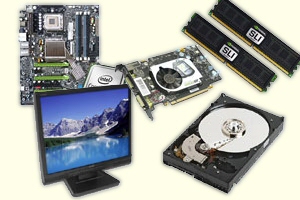
S - What Does That Motherboard Terminology Mean?
Serial Advanced Technology Attachment (SATA):
SATA (Serial ATA) is an interface standard for connecting hard drives to computer systems, and is based on serial signaling technology. The advantages over PATA include longer, thinner cables for more efficient airflow within a computer chassis, fewer pin conductors for reduced electromagnetic interference, and lower signal voltage to minimize noise margin. The bandwidth of SATA is also far improved over today’s PATA - the SATA 1.0 can reach a maximum of 1.5Gb/s (150MB/s), while the latest SATA 2.5 standard can support up to 3Gb/s (300MB/s). As a result of so many advantages, the SATA interface is gradually replacing PATA as the mainstream hard drive interface in the personal storage market.
Serial Port:
Unlike parallel port, serial port (aka COM) is an interface on a computer system which transfers information one bit at a time. Most serial ports of personal computer uses RS-232 standard, and RS-232 is still commonly used in industry devices. Serial port has also been replaced by USB ports (and PS/2 ports). This is also known as COM ports, serial ports are used to connect peripherals to your PC such as modems, PDA, and digital cameras.
Slot 1:
This is the CPU connector for early Intel Pentium III processors.
Small Computer System Interface (SCSI):
SCSI (Small Computer System Interface) is a standard interface for transferring data between devices and computers. Thanks to its outstanding ability to compartmentalize diverse operation, SCSI is very suitable for multitasking operating environments. Also, SCSI enhances critical performance in situations where more than one device is connected. Before serial signaling technology was applied into the SCSI field, all SCSI interface standards used parallel technology to transfer data. This is similar to EIDE but catering to more corporate market. Up to 15 devices can be connected and transfer rates are far superior to EIDE.
Socket A:
This is the CPU connector for AMD Athlon and Duron processors.
Socket 370:
This is the CPU connector for Intel Celeron and PIII processors.
Socket 478:
This is the CPU connector for Intel Pentium 4 processors.
Sony/Philips Digital Interface (S/PDIF):
S/PDIF (Sony/Philips Digital Interface) is a digital audio interface widely used in consumer electronics and sound cards. There are several different types of cables and connectors for S/PDIF:
1. Coaxial or RCA jack, digital audio information is transferred in the form of an electronic signal.
2. Optical or “TOSLINK”, all information is transferred in optical signal form.
Southbridge:
The Southbridge (Intel calls it the ICH or Input/Output Controller Hub) provides connections to I/O devices, such as the PCI bus, USB, PATA, SATA and PCI Express devices. Other Southbridge functions include interrupt controller, real time clock, power management (ACPI and APM), SMBus and so on. Southbridge chips are usually connected to Northbridge chips.
Symmetric MultiProcessing (SMP):
This is a multiprocessor configuration where two or more processors share the memory and system bus.
Synchronous Dynamic Random Access Memory (SDRAM):
SDRAM (Synchronous Dynamic Random Access Memory) has a synchronous interface. It waits for a clock pulse before transferring data and is therefore synchronous with the computer system bus and processor. This greatly improves performance over asynchronous DRAM. It is a fast system memory that superseded EDO RAM.

